

An Interview with
JOHN LASSETER
Part 1

By Lawrence French

LAWRENCE FRENCH: How did the idea for A BUGíS LIFE come about?
JOHN LASSETER: We were toying with numerous different ideas for our next movie, and up came the idea of doing insects in our medium, which is a real natural. Then we were talking about Aesopís fables and "The Ant and The Grasshopper". We kind of take it and turn it on itís ear a little bit, where the grasshopper takes revenge on the ants. Thatís where the idea kind of evolved from. Then the more we talked about it, and the more we looked at bugs, the more excited we got, because of all the possibilities.
LAWRENCE FRENCH: As a kid, did you like playing with bugs?
JOHN LASSETER Yes, I loved bugs as a kid. I have five sons now, and we live up in the country in Sonoma, so thereís lotís of bugs around. Almost every empty jar we own has holes poked in the lid. I grew up in Whittier in southern California, so, besides ants and grasshoppers, pillbugs where my favorites.
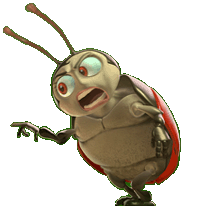 They would roll up in a ball, and youíd wait for them to open back up. Technically, theyíre not insects, but crustaceans. If you look at them closely, theyíre similar to a crab. I never had stickbugs or praying mantisí much as kids, but I just love the look of them. As we started researching for the movie, we found some insects in the rainforests that are stunningly iridescent. Some of the beetle shells are so beautifully iridescent, itís amazing. It was trying to get a combination of bugs people were familiar with, but also bugs we were inspired by, like big rhino bugs and ladybugs. Ladybugs were one of the first things we thought of, because I loved those as a kid. We said, Ďit could be like a guy that carries a big chip on his shoulder, because everyone assumes heís a ladyí. Then when we started researching voices, Denis Leary was a real natural for the ladybugís voice.
They would roll up in a ball, and youíd wait for them to open back up. Technically, theyíre not insects, but crustaceans. If you look at them closely, theyíre similar to a crab. I never had stickbugs or praying mantisí much as kids, but I just love the look of them. As we started researching for the movie, we found some insects in the rainforests that are stunningly iridescent. Some of the beetle shells are so beautifully iridescent, itís amazing. It was trying to get a combination of bugs people were familiar with, but also bugs we were inspired by, like big rhino bugs and ladybugs. Ladybugs were one of the first things we thought of, because I loved those as a kid. We said, Ďit could be like a guy that carries a big chip on his shoulder, because everyone assumes heís a ladyí. Then when we started researching voices, Denis Leary was a real natural for the ladybugís voice.
LAWRENCE FRENCH: The ladybug is an example of taking something that everyone knows, and looking at it in a different way. Did you use that approach on anything else in A BUGíS LIFE?
JOHN LASSETER: Yes, we did that with the world all around the insects. Take a look at a clover. Everyone knows what clover is, this little thing you walk on, thatís so small. But take a look at a clover as if it were the size of a very tall tree.
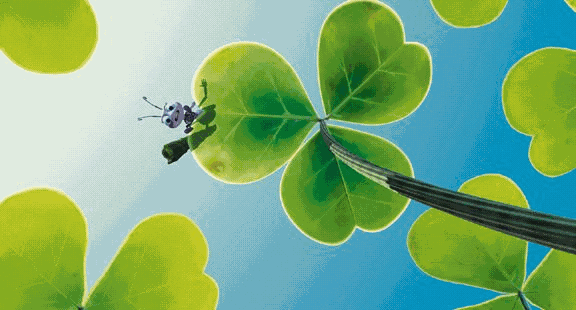 Youíd look up, and be under the canopy of these giant clover leaves, with the sun back lighting them. Where the ants live is just a little island in the middle of a dry riverbed, but from an antís point of view itís like the grand canyon. Having a small riverbed or a tree is to us, not terribly big, but to an ant itís like the feeling you have when you walk to the edge of the grand canyon for the first time. You know, you park your car, get out and walk along a way, go up over a little rise, and there right in front of you is the grand canyon.
It is so vast, a scale beyond what youíre normally used to, it literally takes your breath away. The same with Yosemite (National Park). I grew up growing to Yosemite every summer, and you stand in the middle of a meadow, and look up at half dome and itís a scale youíre not used to seeing.
Youíd look up, and be under the canopy of these giant clover leaves, with the sun back lighting them. Where the ants live is just a little island in the middle of a dry riverbed, but from an antís point of view itís like the grand canyon. Having a small riverbed or a tree is to us, not terribly big, but to an ant itís like the feeling you have when you walk to the edge of the grand canyon for the first time. You know, you park your car, get out and walk along a way, go up over a little rise, and there right in front of you is the grand canyon.
It is so vast, a scale beyond what youíre normally used to, it literally takes your breath away. The same with Yosemite (National Park). I grew up growing to Yosemite every summer, and you stand in the middle of a meadow, and look up at half dome and itís a scale youíre not used to seeing.
 Itís really huge, and exciting. So we were inspired by that and also southern Utah. and the rock formations in Bryce canyon. I was there on vacation a couple of summers ago, and out of that came the inspiration of using a root as a massive arch that towers above them. We call it the root arch, which is the entrance to the anthill, where they come in and out. That was very much inspired by Rainbow arch near lake Powell. Then, the river bed around the island they live on, is like the grand canyon. So itís that kind of thing, where we appeal to the audiences sense of familiarity in two different ways: like this is a human sized riverbed, but itís so huge to an ant, that itís like the grand canyon.
Itís really huge, and exciting. So we were inspired by that and also southern Utah. and the rock formations in Bryce canyon. I was there on vacation a couple of summers ago, and out of that came the inspiration of using a root as a massive arch that towers above them. We call it the root arch, which is the entrance to the anthill, where they come in and out. That was very much inspired by Rainbow arch near lake Powell. Then, the river bed around the island they live on, is like the grand canyon. So itís that kind of thing, where we appeal to the audiences sense of familiarity in two different ways: like this is a human sized riverbed, but itís so huge to an ant, that itís like the grand canyon.
LAWRENCE FRENCH: Youíve done considerable research on ants and insects, but obviously donít feel constrained by making the film too realisticóafter all, it is a cartoon.
JOHN LASSETER: Yes, that goes back to the beginnings of Pixar, where we analyze aspects of our technology and imagery, and try to mimic the limitations of the motion picture cameraóbecause that is what the audience is used to seeing. If they donít see motion blur, or depth of field, it doesnít look real to them. Thatís part of the charm about what we do, because in creating such an obvious fantasy world, that doesnít exist (and we never pretend it does)óit maintains the believability of this world. Once you get past the fantasy, with motion-blur, and the beautiful lighting and shadows, the reflections and refractionísóitís all those things combined, and with the clear knowledge of using that, that maintains the believability of this world. It puts the audience in the place of knowing itís not real, but it looks so real. On A BUGíS LIFE itís a step beyond what we did with TOY STORY, because weíve really put a tremendous amount of effort into the believability of this environment. We did a lot of studying of insect documentaries, like MICROCOSMOS, national geographic specials, and all those kinds of things. One of the things we became aware of, is when you photograph a world this small, the camera in order to focus, has a shallow depth of field. The little bug is in focus, and the leaves and things in front of it and behind it are out of focus. So that was something we wanted to use in the movie. With our system we have the capability to create either a tremendous depth of field, or a shallow depth of field. So even though this is a wide screen movie, epic in itís staging and vistas, we still have times when things are right in front of a character, or right behind a character that are out of focus.
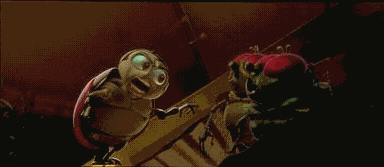 When Flik climbs up a dandelion and is about to parachute across the riverbed, heís in focus, but the dandelion branches around him are not. So we were trying to find these kind of constant reminders that this is really a tiny world. We didnít do it by putting a can, or some other man-made objects around all the time so people had a point of reference, but more by finding things in nature. People donít realize it, but there is a familiarity in the way insects are photographed, which is due to the limitations of the the motion picture camera, or the still camera.
When Flik climbs up a dandelion and is about to parachute across the riverbed, heís in focus, but the dandelion branches around him are not. So we were trying to find these kind of constant reminders that this is really a tiny world. We didnít do it by putting a can, or some other man-made objects around all the time so people had a point of reference, but more by finding things in nature. People donít realize it, but there is a familiarity in the way insects are photographed, which is due to the limitations of the the motion picture camera, or the still camera.
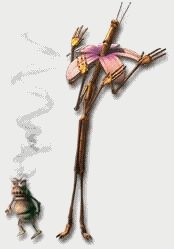 If they made cameras and lenses that were the size of insects, then it would feel like just as if you were photographing a human. But because your trying to focus on a small bug, with a human size camera, you get that a very shallow focus. So itís very well thought out, from the stand point of thinking of the audience, and trying to put them into this very believable world. We shot a lot of footage on this bugcam. Itís a little miniature
camera on a stick, on little wheels. We just took this camera and videotaped all sorts of things right outside and in the park across the way. Leaves on the ground, and we realized how beautiful the world on this level is, because itís all translucent. I thought, Ďimagine a world where all the buildings around you are made of stained glassí. It became so exciting. When leaves are back lit, there color is so vibrant, and when there in shadow, their dark. So that inspired us, the potential of beautiful saturated colors and the light, because we really wanted to make this an absolutely beautiful film. We also looked at the insects through a telescope, which gives you that sense of depth of field, which was fun.
If they made cameras and lenses that were the size of insects, then it would feel like just as if you were photographing a human. But because your trying to focus on a small bug, with a human size camera, you get that a very shallow focus. So itís very well thought out, from the stand point of thinking of the audience, and trying to put them into this very believable world. We shot a lot of footage on this bugcam. Itís a little miniature
camera on a stick, on little wheels. We just took this camera and videotaped all sorts of things right outside and in the park across the way. Leaves on the ground, and we realized how beautiful the world on this level is, because itís all translucent. I thought, Ďimagine a world where all the buildings around you are made of stained glassí. It became so exciting. When leaves are back lit, there color is so vibrant, and when there in shadow, their dark. So that inspired us, the potential of beautiful saturated colors and the light, because we really wanted to make this an absolutely beautiful film. We also looked at the insects through a telescope, which gives you that sense of depth of field, which was fun.
LAWRENCE FRENCH: Both TOY STORY and A BUGíS LIFE deal with a very small-scaled world.
JOHN LASSETER: Yes, Iíve found that people have this innate interest in miniature worlds. Thereís something people find fascinating in dioramas at museums, or model train landscapes. Since TOY STORY came out, from talking with people, and also based on my own interests, I started thinking about that, and analyzing it. I think itís manifested in these extensive model train clubs, where you find these big model railroad layouts, with different stations, mountains and bridges. Ever since I was a kid that was my favorite thing to do at the fair. Or at the natural history museum where they have these dioramas, of some battle, or the gold rush, and I remember always staring at those. Itís something I would get sucked into. Even at Christmas time, I would be at a friends house and see a little street with houses lit up on the mantel. From that, I started thinking, there is such believability to what we do, and itís so dimensional, it kind of taps into this interest in miniature worlds. Of course, we take our world one step further, because itís got thinking, moving creatures in it. But thereís something fun about these miniature worlds. In A BUGíS LIFE, we have a scene that weíre so excited about. Itís where Flik goes to the city to find the warrior bugs, and thatís where he finds the circus bugs, who have just been fired from P.T. Fleas circus. 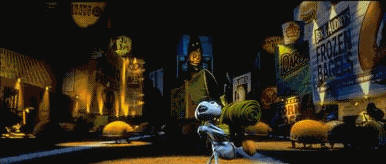 The city is a real fun thing, because in reality it is an old beat up trailer, out in the countryside, with a wooden deck porch, and underneath the deck is just piles of trash. But we get down from an insect point of view, and go under the porch, and see the trash piled up in such a way that it looks just like Times square, with all the labels of packages facing in, and thereís fireflies flying around, and bugs teaming back and forth. We created these beetles, that are yellow, with black and white little spots that look like checker cabs, and theyíre running all over the place. So here we took something really familiaróa pile of trash, and make people look at it from a bugís point of view, and it looks like something else thatís familiar to people, and thatís Times Square. We wanted to take Flik and make it seem as though he were a country boy getting off the bus at the Port Authority bus station in New York, and there he is in Times square, so his reaction is, Ďwow, itís the cityí. Then, Flik goes in this bar, which is an old rusty can, and they have bottle caps for tables. Since bugís can walk on walls, the tables go all the way up the side of the can. In these Times Square shots, thereís over 150 characters that are all hand animated. Itís doing bits of animation for all these characters, so they just fill up the streets.
The city is a real fun thing, because in reality it is an old beat up trailer, out in the countryside, with a wooden deck porch, and underneath the deck is just piles of trash. But we get down from an insect point of view, and go under the porch, and see the trash piled up in such a way that it looks just like Times square, with all the labels of packages facing in, and thereís fireflies flying around, and bugs teaming back and forth. We created these beetles, that are yellow, with black and white little spots that look like checker cabs, and theyíre running all over the place. So here we took something really familiaróa pile of trash, and make people look at it from a bugís point of view, and it looks like something else thatís familiar to people, and thatís Times Square. We wanted to take Flik and make it seem as though he were a country boy getting off the bus at the Port Authority bus station in New York, and there he is in Times square, so his reaction is, Ďwow, itís the cityí. Then, Flik goes in this bar, which is an old rusty can, and they have bottle caps for tables. Since bugís can walk on walls, the tables go all the way up the side of the can. In these Times Square shots, thereís over 150 characters that are all hand animated. Itís doing bits of animation for all these characters, so they just fill up the streets.
LAWRENCE FRENCH: On TOY STORY you talked about the integrity of the characters, how you analyzed each toy to see how it would move or function if they were really alive. Did you also do that for the bugs in this movie?
JOHN LASSETER: Yes, with the circus bugs we studied them to figure out what they might do as circus performers. We were constantly thinking of the integrity of the bug, and what they could do. We also wanted to have a wide variety of insects, and from a story standpoint, it was important that the ants could look at this collection of  bugs, and kind of believe, for some reason or other, that theyíre tough warrior bugs. It was a dual thing, where they had to be believable, from an ants point of view, as tough warrior bugs, and be part of the circus. Many of the choices were kind of obvious, like a rhino beetle and a praying mantis. The pillbugs, Tuck and Roll, the fact that they roll up in a ball, lent itself to making them acrobats. They roll and pop and climb around on each other. Rosie, the spider, being able to string up a web, we thought of her as a tightrope walking kind of high wire act. The rhino beetle, Dim is very strong, like the elephant of the circus, and can carry about 80 times there own body weight. The praying mantis, the more we studied it, it seemed like he was dressed up, with big French cuffs, and that headed us to the notion of a magician, and the way his wings are, it looks like a tuxedo dinner jacket, and his body has a kind of built in ascot. Heís know as Manny, formerly ĎManto the magnificent.í Gypsy, his lovely wife and assistant, has these beautiful wings, which are almost like a cape. We studied a lot of magicians, and were inspired by classic vaudevillian magic acts. But the assistants are as interesting as the magicians, because theyíre dressed beautifully, and are there to draw your eye away from whatís happening at times. The problem we had with gypsy, was she was like a Vanna White type of character. We kept saying, Ďhow is she going to come off as a warrior?í How could Vanna White show up in small town in the mid-west and people buy her as a warrior? Well, in doing our research, we found that thereís a certain kind of moth, that when it opens it wings, from the back it has these owl like eyes, as a
bugs, and kind of believe, for some reason or other, that theyíre tough warrior bugs. It was a dual thing, where they had to be believable, from an ants point of view, as tough warrior bugs, and be part of the circus. Many of the choices were kind of obvious, like a rhino beetle and a praying mantis. The pillbugs, Tuck and Roll, the fact that they roll up in a ball, lent itself to making them acrobats. They roll and pop and climb around on each other. Rosie, the spider, being able to string up a web, we thought of her as a tightrope walking kind of high wire act. The rhino beetle, Dim is very strong, like the elephant of the circus, and can carry about 80 times there own body weight. The praying mantis, the more we studied it, it seemed like he was dressed up, with big French cuffs, and that headed us to the notion of a magician, and the way his wings are, it looks like a tuxedo dinner jacket, and his body has a kind of built in ascot. Heís know as Manny, formerly ĎManto the magnificent.í Gypsy, his lovely wife and assistant, has these beautiful wings, which are almost like a cape. We studied a lot of magicians, and were inspired by classic vaudevillian magic acts. But the assistants are as interesting as the magicians, because theyíre dressed beautifully, and are there to draw your eye away from whatís happening at times. The problem we had with gypsy, was she was like a Vanna White type of character. We kept saying, Ďhow is she going to come off as a warrior?í How could Vanna White show up in small town in the mid-west and people buy her as a warrior? Well, in doing our research, we found that thereís a certain kind of moth, that when it opens it wings, from the back it has these owl like eyes, as a  defense mechanism, so we used that and made her a much more ferocious creature. It really made it kind of neat. The circus bugs were exciting, because it opened the door to all kinds of beautiful bugs from anywhere in the world, and it made
defense mechanism, so we used that and made her a much more ferocious creature. It really made it kind of neat. The circus bugs were exciting, because it opened the door to all kinds of beautiful bugs from anywhere in the world, and it made  perfect sense. The littlest one of them all is the owner, P.T. Flea, who is a real money-grubbing parasite. Itís a real run down circus, and as we say they canít even draw flies. The audience they have left is just a few flies, and thatís about it.
perfect sense. The littlest one of them all is the owner, P.T. Flea, who is a real money-grubbing parasite. Itís a real run down circus, and as we say they canít even draw flies. The audience they have left is just a few flies, and thatís about it.
Part 2 of the John Lasseter Interview
now available